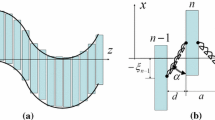Abstract
The formation of wave structures on an unstable (in the Rayleigh-Taylor criterion) boundary of a plane cavity is studied using high-speed video filming. It is shown that at the head of the cavity a quasiperiodic wave regime develops, with a mean wavelength similar to that obtained from a linear stability analysis for the cavity boundary. Observations of the initial-regime breakdown show that its scenarios are similar to the development of subharmonic instability in the one-mode regime. The waves are classified with respect to the wave development rate. It is shown that the large-wave amplitude growth law is on average closely approximated by a quadratic parabola, with the total gas entrainment from the cavity being proportional to the square of the cavity length. The existence of a scaling effect is detected, which in the case considered reduces mainly to a dependence of the gas entrainment coefficient on the Weber number. It is shown that with decrease in the Weber number the gas entrainment coefficient may significantly increase.
Similar content being viewed by others
References
I.I. Kozlov and V.V. Prokof’ev, “Gas Entrainment from a Ventilated Cavity with a Negative Cavitation Number,” Fluid Dynamics 36(5), 751–763 (2001).
V.P. Karlikov, O.V. Molodykh, and G.I. Sholomovich, “On Turbulent Separated Flows Past a Truncated Body of Revolution,” Fluid Dynamics 31(6), 837–844 (1996).
M.I. Gurevich, Theory of Inviscid-Fluid Jets [in Russian], (Nauka, Moscow, 1979).
I.I. Kozlov and V.V. Prokof’ev, “Wave Development Mechanisms on the Surface of a Cavity with a Negative Cavitation Number,” Dokl. Ross. Akad. Nauk 409(1), 43–47 (2006).
S.Ya. Gertsenshtein, V.M. Chernyavskii, and Yu.M. Shtemler, “Rayleigh-Taylor Instability at Large Times,” Fluid Dynamics 24(5), 661–669 (1989).
N.A. Inogamov, A.Yu. Dem’yanov, and É.E. Son, Hydrodynamics of Mixing [in Russian], (MPhTI, Moscow, 1999).
I.I. Kozlov, V.V. Prokof’ev, and A.A. Puchkov, Investigations of the Flow Around a Cavity with a Negative Cavitation Number Using a High-Speed Videocamera, Report of Institute of Mechanics MSU, No. 4846 (2006).
I.I. Kozlov and V.V. Prokof’ev, “About Different Modes of Carry-Over of Gas from Ventilated Cavity with Negative Cavitation Number,” in: Proc. Int. Summer Sci. School HSH-2004. Cheboksary. Russia, (2004), 97–104.
Additional information
Original Russian Text © I.I. Kozlov, V.V. Prokof’ev, A.A. Puchkov, 2008, published in Izvestiya Rossiiskoi Akademii Nauk, Mekhanika Zhidkosti i Gaza, 2008, Vol. 43, No. 2, pp. 137–148.
Rights and permissions
About this article
Cite this article
Kozlov, I.I., Prokof’ev, V.V. & Puchkov, A.A. High-speed videocamera investigation of the wave structure development on an unstable cavity boundary. Fluid Dyn 43, 287–296 (2008). https://doi.org/10.1134/S0015462808020130
Received:
Published:
Issue Date:
DOI: https://doi.org/10.1134/S0015462808020130




